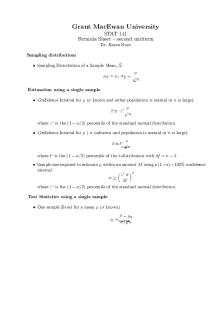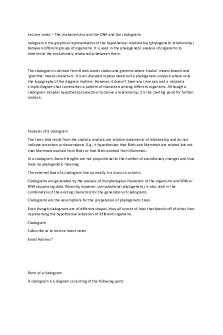Lecture notes – The aluminium oxide and the plain formula PDF

| Title | Lecture notes – The aluminium oxide and the plain formula |
|---|---|
| Course | Biology |
| Institution | University of Salford |
| Pages | 3 |
| File Size | 41.9 KB |
| File Type | |
| Total Downloads | 19 |
| Total Views | 132 |
Summary
Biology notes are useful for exams the can be useful and they can also be used to make your own exam notes and for indepth understanding!!!!...
Description
Lecture notes – The aluminium oxide and the plain formula The relative molecular mass/relative formula mass is defined as the sum of all the individual atomic masses of ALL the atoms in the formula (Mr).
If the individual atomic masses of all the atoms in a formula are added together you have calculated the relative formula mass
Atomic masses are listed at the bottom of the page
e.g. for ionic compounds e.g. NaCl = 23 + 35.5 58.5) or molecular mass for covalent elements or compounds ...
e.g. Mr of N2 = 28 from (2 x 14) or compounds e.g. Mr of C6H12O6 = 180 from [(6 x 12) + (12 x 1) + (6 x 16)],
and more examples of how to calculate relative formula mass are further down the page, you get atomic masses from your periodic table.
In a balanced chemical symbol equation, the total of relative formula masses of the reactants is equal to the total relative formula masses of the products (see law of conservation of mass calculations).
To be honest, the term relative formula mass can be used with any compound whether it be ionic or covalent - it just seems NOT correct to talk about the molecular mass of an ionic compound when it doesn't consist of molecules, but is that one for the purists!
The shorthand Mr can be used for the formula of any element or compound and to repeat, 'it doesn't matter whether a compound is ionic or covalent'.
Mr = Relative formula mass = relative molecular mass
= the sum of all the atomic masses for ALL the atoms in a given formula
NOTE: You cannot successfully calculate formula/molecular masses if you cannot read a formula correctly!
Whereas relative atomic mass (section 1. Relative Atomic Mass) only applies to a single atom, anything with at least two atoms in the formula requires the term relative formula mass or relative molecular mass to be used.
WARNING: The most common error is to use atomic/proton numbers instead of atomic masses, unfortunately, except for hydrogen, they are different!
Examples of relative formula mass or relative molecular mass calculations:
How to calculate relative molecular mass = How to calculate relative formula mass
Molecular/formula mass = total of all the atomic masses of ALL the atoms in the molecule/compound.
Watch out for brackets e.g. (OH)2 means two OH groups to add up!
Relative molecular mass/formula mass calculation Example 2.1 The diatomic molecules of the elements hydrogen H2 and chlorine Cl2 relative atomic masses, Ar: H = 1, Cl = 35.5 Formula masses, RMM or Mr relative molecular mass for hydrogen H2 = 2 x 1 = 2 relative molecular mass for chlorine Cl2 = 2 x 35.5 = 71 respectively. Relative molecular mass/formula mass calculation Example 2.2 The element phosphorus consists of P4 molecules. (atomic mass of P = 31) relative molecular mass or Mr of phosphorus = 4 x its atomic mass = 4 x 31 = 124 Relative molecular mass/formula mass calculation Example 2.3: The compound water H2O relative atomic masses are H=1 and O=16 relative molecular mass or Mr = (1x2) + 16 = 18 (molecular mass of water) Relative molecular mass/ relative formula mass calculation Example 2.4 The compound sulphuric acid H2SO4 when pure, is a covalent compound relative atomic masses are H = 1, S = 32 and O = 16
relative molecular mass or Mr = (1 x 2) + 32 + (4 x 16) = 98 (molecular mass of sulphuric acid ) Relative formula mass calculation Example 2.5 The compound magnesium hydroxide Mg(OH)2 (ionic) relative atomic masses are Mg = 24, H = 1 and O = 16 relative formula mass or Mr = 24 + 2 x (16+1) = 58 Important note on terminology The term relative formula mass is best applied to giant structure compounds e.g. ionic compounds like magnesium hydroxide (above), and silicon dioxide SiO2 (RFM = 28 + 16 + 16 = 60), a 3D giant covalent lattice compound. Relative formula mass calculation Example 2.6 The ionic compound aluminium oxide (Al3+)2(O2-)3 or just the plain formula Al2O3 but it makes no difference to the calculation of relative formula mass or relative molecular mass. relative atomic masses are Al = 27 and O = 16 so the relative formula mass RFM or Mr = (2 x 27) + (3 x 16) = 102 Relative formula mass calculation Example 2.7 Calcium phosphate is also ionic but a more tricky formula to work out! (Ca2+)3(PO43-)2 or Ca3(PO4)2, but it makes no difference to the calculation of relative formula mass or relative molecular mass. atomic masses: Ca = 40, P = 31, O =16 relative formula mass or Mr = (3 x 40) + 2 x {31 + (4 x 16)} = (120) + (2 x 95) = 310 Relative molecular mass/formula mass calculation Example 2.8 Glucose C6H12O6 a covalent compound atomic masses: C = 12, O= 16, H = 1 relative molecular mass of glucose Mr(C6H12O6) = (6 x 12) + (12 x 1) + (6 x 16) = 180 Relative molecular mass calculation Example 2.9...
Similar Free PDFs

02 Aluminium and aluminium alloy
- 112 Pages

Lecture notes, lecture formula 2
- 1 Pages

The Cytoskeleton Lecture Notes
- 4 Pages

the lecture notes (gattaca)
- 2 Pages
Popular Institutions
- Tinajero National High School - Annex
- Politeknik Caltex Riau
- Yokohama City University
- SGT University
- University of Al-Qadisiyah
- Divine Word College of Vigan
- Techniek College Rotterdam
- Universidade de Santiago
- Universiti Teknologi MARA Cawangan Johor Kampus Pasir Gudang
- Poltekkes Kemenkes Yogyakarta
- Baguio City National High School
- Colegio san marcos
- preparatoria uno
- Centro de Bachillerato Tecnológico Industrial y de Servicios No. 107
- Dalian Maritime University
- Quang Trung Secondary School
- Colegio Tecnológico en Informática
- Corporación Regional de Educación Superior
- Grupo CEDVA
- Dar Al Uloom University
- Centro de Estudios Preuniversitarios de la Universidad Nacional de Ingeniería
- 上智大学
- Aakash International School, Nuna Majara
- San Felipe Neri Catholic School
- Kang Chiao International School - New Taipei City
- Misamis Occidental National High School
- Institución Educativa Escuela Normal Juan Ladrilleros
- Kolehiyo ng Pantukan
- Batanes State College
- Instituto Continental
- Sekolah Menengah Kejuruan Kesehatan Kaltara (Tarakan)
- Colegio de La Inmaculada Concepcion - Cebu











